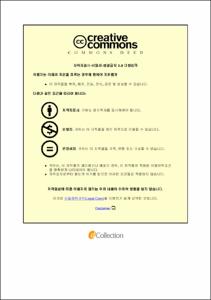CFD를 이용한 패키지형 개질기의 수소 누출에 따른 폭발 위험거리 산정에 대한 연구
- Abstract
- 국내에서는 수소를 차세대 에너지원으로 활용하는 수소경제의 한 축으로서 수소차량을 위한 수소충전소 보급 및 상용화에 많은 노력을 기울이고 있다. 이러한 이유로 각종 수소설비들에 대한 경제성뿐만 아니라 안전성에 대한 검토도 많이 진행되고 있지만 아직까지 수소충전 설비들의 안전관리에 필요한 기초 데이터들에 대한 연구는 충분히 이루어지지 못한 상태이다. 특히 수소설비에서의 가장 피해가 클 것으로 예상되는 폭발과 관련해서도 위험영역 범위 산정기준과 같은 중요한 자료들에 대해서 명확하게 제시되지 않고 있다. 최근에는 10 bar 미만의 수소가스의 안전관리를 위해 수소안전법이 제정되었으나 8 bar 정도로 작동되는 수소 개질기는 모두 환기를 이용한 비방폭설비로 구성되어 있어 폭발 위험거리 산정기준과 비방폭설계 허용 기준이 명확하지 않아 이에 대한 검토가 필요한 실정이다.
한편 IEC 60079-10-1에서는 누출원에서 직접 누출되는 경우에 대해서 폭발 위험거리에 대한 자료가 제시되어 있지만 실내에서의 1차 누출 후 옥외로 확산되는 경우와 같이 실질적으로 존재할 수 있는 다양한 조건에서의 폭발 위험거리에 대한 자료는 제시되어 있지 않다.
따라서 본 연구에서는 패키지형 수소 개질기 내부의 배관 이음부에서 발생한 수소 누출에 대해 IEC 60079-10-1(폭발성가스분위기의 위험장소 구분)에따라 폭발 위험거리를 산정하였고 NIST에서 개발한 Fire Dynamic Simulator (FDS)를 이용한 시뮬레이션 결과와 비교하여 그 타당성을 검토하였다.
누출된 수소의 확산범위는 IEC 60079-10-1의 차트에 따라 산정한 위험거리 범위 결과와 비교하여 큰 차이를 보이는 것을 확인하였다. 특히 패키지형 설비의 환기구 배치나 형상에 따라서도 상이함을 확인할 수 있었는데 누출구멍의 크기가 커질수록(누출되는 수소의 양이 많아질수록) 수소의 분포거리는 부력으로 인해 큰 차이가 발생함을 확인하였다.
In Korea, as one of the pillars of the hydrogen commercialization policy that utilizes hydrogen as a next-generation energy source, much effort is being made to supply and commercialize hydrogen fuel stations for vehicles. For this reason, not only economic feasibility but also safety of various hydrogen facilities are being reviewed, but research on basic data necessary for safety management of hydrogen facilities has not been sufficiently conducted yet. In particular, important data such as criteria for calculating the range of dangerous areas have not been clearly presented regarding the explosion, which is expected to cause the most damage to hydrogen facilities. Recently, the Hydrogen Safety Act has been enacted for the safety management of hydrogen gas of less than 10 bar, but all hydrogen reformers operated at about 8 bar are composed of non explosion protection equipment using good ventilation, so it is necessary to review this.
Meanwhile, IEC 60079-10-1 provides data on the risk of explosion in various conditions, such as the case of direct leakage from a source, but does not provide data on the risk of explosion under various practical conditions, such as spreading outdoors after primary leakage indoors.
Therefore, in this study, the risk of explosion was calculated according to IEC 60079-10-1 (Explosive Gas Atmosphere - hazardous are classification) for hydrogen leaks inside the packaged hydrogen reformer, and the extent of hazardous area was compared with simulation results by Fire Dynamic Simulator(FDS) developed by NIST and the validity was reviewed.
It was confirmed that the diffusion range of leaked hydrogen showed a significant difference compared to the result of the risk range calculated according to the chart of IEC 60079-10-1. In particular, it could be confirmed that the ventilation hole arrangement or shape of the package-type facility is different, and as the size of the leakage hole increases (the amount of hydrogen leaked increases), the distribution distance of hydrogen varies greatly due to buoyancy.
- Issued Date
- 2022
- Awarded Date
- 2022. 2
- Type
- Dissertation
- Publisher
- 부경대학교
- Affiliation
- 부경대학교 산업대학원
- Department
- 산업대학원 안전공학과
- Advisor
- 오창보
- Table Of Contents
- 제1장. 서론 1
1.1. 연구 배경 1
1.2. 연구 목적 5
제2장. 수소의 화재·폭발 위험성 6
2.1. 수소의 특성 6
2.1.1. 물리적 성질 6
2.1.2. 화학적 성질 6
2.1.3. 화재·폭발에 관한 성질 6
2.2. 수소 폭발사고 사례 11
2.2.1. 강원 테크노파크 수소탱크 폭발사고 11
2.2.2. 노르웨이 수소충전소 폭발사고 12
2.2.3. 최근 10년간 수소사고 발생현황 14
2.2.4. 수소충전소의 확대와 안전대책 16
제3장. 수소충전설비 및 법적 규제 19
3.1. 수소충전설비의 개요 19
3.1.1. 수소충전설비 19
3.1.2. 수소개질기(Hydrogen Reformer) 21
3.2. 수소충전설비 관련 법규 및 기준 23
3.2.1. 수소경제 육성 및 수소안전관리에 관한 법률 23
3.2.2. 고압가스 안전관리법 23
3.2.3. 산업안전보건법 23
3.2.4. IEC 60079-10-1 24
3.2.5. IEC 60079-13 24
3.2.6. ISO 19880-1 25
제4장. 개질기의 폭발위험장소 범위 산정 26
4.1. 폭발위험장소 구분 개요 26
4.1.1. 폭발위험장소 구분의 목적 26
4.1.2. 폭발위험장소의 종별 26
4.1.3. 폭발위험장소의 범위와 안전거리 27
4.2. IEC 60079-10-1을 이용한 폭발위험장소 범위 산정 28
4.2.1. 누출원 및 누출등급 28
4.2.2. 누출 구멍의 크기 29
4.2.3. 누출계수(Cd)의 결정 31
4.2.4. 압축계수(Z)의 결정 31
4.2.5. 인화하한(LFL)의 안전계수(k)의 결정 31
4.2.6. 환기풍속(uw)의 결정 32
4.2.7. 수소가스의 누출률(Release rate) 33
4.2.8. 희석등급 평가(Degree of dilution) 35
4.2.9. 폭발위험장소 종별(zones) 결정 38
4.2.10. 폭발위험장소 범위(extent of zone) 결정 39
4.3. CFD를 이용한 폭발위험장소 범위 비교 43
4.3.1. 전산유체역학 개요 43
4.3.2. FDS 지배방정식 44
4.3.3. FDS 시뮬레이터의 설정 조건 47
4.3.4. 환기구 배치 모델 53
4.3.5. 누출 시간의 영향 54
4.3.6. 환기구 배치 및 옥외 풍속의 영향 55
제5장. 결론 62
참고문헌 64
- Degree
- Master
- Files in This Item:
-
-
Download
 CFD를 이용한 패키지형 개질기의 수소 누출에 따른 폭발 위험거리 산정에 대한 연구.pdf
기타 데이터 / 11.99 MB / Adobe PDF
CFD를 이용한 패키지형 개질기의 수소 누출에 따른 폭발 위험거리 산정에 대한 연구.pdf
기타 데이터 / 11.99 MB / Adobe PDF
-
Items in Repository are protected by copyright, with all rights reserved, unless otherwise indicated.